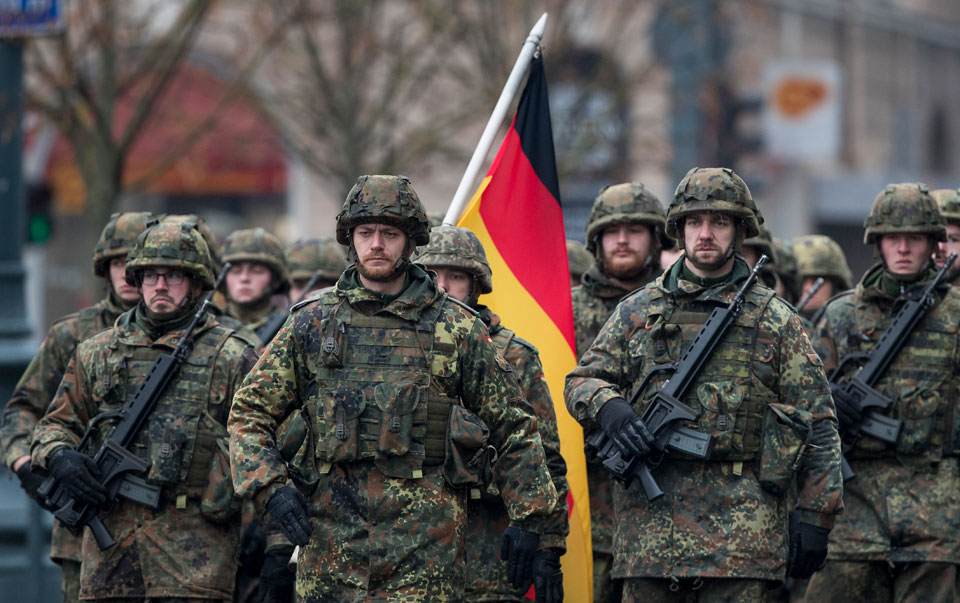
BERLIN—While Donald Trump dominates the news daily in the U.S. with his racist diatribes, tweets, and rallies, the American public can’t be blamed if it fails to notice that on a world scale and here in Europe, in particular, the right wing is pushing for a level of militarization and war planning that goes beyond much of what we have seen before.
NATO, with the backing of Germany, the U.K., and the United States, is quietly arming to the teeth dangerous governments in Europe and Africa and readying itself for military strikes in the Middle East and against Russia. On a regular basis, thousands are camping out in protest against these plans at the Ramstein military base in southwestern Germany, the largest American military base outside the continental U.S. Peace activists from around the world have also descended upon another location in Germany where the U.S. has readied 20 nuclear missiles for use at any moment.
Developments this week here put Germany, the power behind the European Union, squarely in the camp of NATO’s war hawks with Ursula von der Leyen’ s narrow election to the chairmanship of the European Commission, the 28-member “cabinet,” so to speak, of the European Union. Each of the member countries nominates a member of that commission whose chair is then elected by the 751-member European Parliament.

Despite having cultivated the reputation internationally as a “reasonable” leader, especially when compared to Trump, the German Chancellor, Angela Merkel, has been pushing for the elevation of von der Leyen, an extreme militarist, to that post. As the Christian Democratic German Defense Minister for the last five years, von der Leyen has led the biggest military expansion of Germany in three decades. While the racist and fascist forces in Germany use the Alternative for Germany party (AfD) to push their agenda, the military-industrial complex has been able to accomplish much of its agenda through the mainstream Christian Democratic Union party.
The center-left Social Democrats had said up until this week that Merkel never consulted them, her partners in the German coalition government, when she selected von der Leyen and, because of her extreme militarist positions, they said they might not vote for her in the EU elections. The balloting this week was secret, however, and von der Leyen could not have squeaked in by just nine votes in the 751-member European Parliament without some of the German Social Democratic parliamentarians voting for her.
Von der Leyen had campaigned in support of European Commission plans, announced in March, to strengthen and widen highways and rail lines that run west to east across Germany so that troops and tanks “can move quickly eastward from German bases and ports.” Her justification for “improved” east-west highways echoed Hitler’s justification for similar highway “improvements” across Germany in 1935. Von der Leyen has strongly advocated support for an EU military wing in addition to NATO and is now in the position to oversee its development.
Meanwhile, NATO has already integrated into its operation a group of German officers who command what NATO is calling a “high readiness task force” that, according to the U.S. NATO general in command at Ramstein, Mark August, “can be sent anywhere in three days.”
Echoing August, von der Leyen said, “Tensions and crisis require quick, solid organization to move troops great distances, and it must be planned with speed and efficiency.”
Sending troops to the modern-day Eastern Front
If her actions prior to her election this week are any indication, she has been scouting out potential sites to host massive increases in German armaments. She recently visited German troops in Lithuania and elsewhere near the Russian border. When Soviet troops pulled out of one country after another in Eastern Europe in 1990, no time was wasted replacing them with U.S. and German troops, under the umbrella of NATO, of course. NATO didn’t stop after rolling the tanks into just the countries from which the Soviets withdrew, however. They pushed far into territory that had been part of the Soviet Union itself. That territory included the Baltic states of Lithuania, Latvia, and Estonia, all former republics of the USSR.
The expansion of NATO into all of these areas violated promises the U.S. made to the Soviet Union that such expansion would never take place and increased the danger of nuclear war between the world’s two biggest nuclear powers, who now maintain military hardware virtually within sight of one another. That level of potential conflict involving the U.S. and Russia has not happened since U.S. and Soviet tanks faced one another head-on only a few feet apart on the streets of Berlin in the early 1960s. It took the construction of the Berlin Wall to de-fuse that confrontation, which also had the potential to turn into nuclear war.
In Latvia, U.S. troops have participated in war games near the Russian border for more than three years now. An activist in the opposition Socialist Party in that country, whose name is withheld because of certain government reprisal, described for People’s World the morning when these maneuvers began and how people in a small Latvian town woke up to the un-announced arrival of U.S. tanks and jeeps. Armed soldiers fanned out across their village and took up positions in front of homes and on street corners. A friend from the town called the party activist at her home in Riga in a state of panic, wanting to know what was happening. The party activist had no information at the time to give her friend but learned later it was one of the war games in which the U.S. troops were involved near the Russian border.
Peace forces note that giving military aid to a dangerous right-wing government like the Latvian government, which is repressing political opposition and making it illegal for anyone to even speak or write positively about anything that happened in the Soviet era, is hardly conducive to strengthening peace and security on the European continent.
While in Lithuania, von der Leyen promised that, in addition to German troops, she would send the Lithuanians 110 million euros to modernize their own military. Lithuania, also under the control of right-wing extremists, now officially celebrates the memory of Lithuanian “heroes” who were members of Hitler’s SS and organized the slaughtering of Jews in the country during World War II.
The U.S., unlike the Russians, has a reputation of remaining forever once it sets foot in a country. Von der Leyen apparently sees that practice as a model for Germany.
“We will stay as long as the security question requires,” she said in Lithuania. “We are the only European continental country to maintain a forward position in the Baltic area protecting our Baltic friends. And,” she bragged, “we are the country with the second-largest number of troops in Afghanistan.”
When German troops entered the Baltic states in the last century, they protected their “friends” thereby killing hundreds of thousands of them and by setting up a network of concentration camps. The military maneuvers the Nazis carried out, in the same areas visited by von der Leyen, were warm-up for the coming siege of Leningrad just across the Soviet border.
German militarism under U.S. guidance
The German militarists would not be able to operate today except for direction they get from the U.S. military. They work in sync today with the U.S. operations directed out of the base at Ramstein.

General August bragged recently that “when you see all the planes lined up here (at Ramstein), you see that this is the place that gets things moving in the direction of Africa, the Middle East, and Eastern Europe,” with the obvious targets he has in mind including Russia and Iran.
As he said, “things” have been moving out of Ramstein for quite a while. It is from there that drones are dispatched to kill individuals in locations in Africa and the Middle East, including Iran, without regard to whether the operations violate international borders.
Farmers, civilians, wedding parties, school buses full of children, and so much more have been blasted off the face of the earth by weapons launched from Ramstein.
Nearby to Ramstein is an Air Force base at Büchel storing 20 ready-to-go B61 nuclear bombs, each with 20 to 30 times the destructive power of the bomb dropped on Hiroshima. Lined up also at that base are German Tornado planes which are equipped to carry and deliver these missiles to their targets.
August and other generals are bragging, however, that soon these planes won’t be needed because they will be able to launch the nuclear missiles direct from their silos in Ramstein to their targets.
The peace offensive
The resistance continues, however. This week, international peace activists from Germany, the Netherlands, the U.K., and the U.S. entered the Büchel Air Base to deliver what they called a Treaty Enforcement Order that said the presence of U.S. nuclear weapons there is “a criminal conspiracy to commit war crimes.” Upon entering the main gate with a “cease and desist order,” they demanded to see the base commander to deliver the order in person.
“We refuse to be complacent in this crime,” said Brian Terell of Voices for Creative Non-Violence in Chicago, Ill. “We call for the nuclear weapons to be returned to the U.S. immediately. The Germans want these nuclear weapons out of Germany, and so do we.”
All 11 activists were detained but released after producing identification.
The local German group, Non-violent Action for Abolition of Nuclear Weapons, has convened an “international action week” demanding the permanent ouster of all U.S. nuclear weapons and cancellation of plans to replace the current B61 missiles with new hydrogen bombs from the U.S.
“This is crime prevention,” said John LaForge of Nukewatch, a U.S. peace group, when asked the purpose of the entry into the Ramstein base. LaForge is the leader of the U.S. delegation to the international action week.
The new bombs, the B61-12’s, slated for shipment to Büchel, are being produced in Kansas City, Kan.
“The plans for training personnel in the eventual use of these bombs is illegal because organizing mass destruction was banned at the Nuremberg trials,” said Susan ven der Hijden, an activist from Amsterdam who is part of the delegation. Before coming to Germany, she had joined protests in Kansas City against the new nukes being manufactured there.
Some sections of the major media here go along with the war planning and carry stories alleging Russian “aggression” that they say necessitates the mobilization. Most Germans, polls show, are for peace, however, and reject the idea that Russia is about to invade or start a war. And nowhere is the situation in the media as bad as it is in the United States, where liberal media often lead the crusade against Russia. The result has been that many in the U.S. see Russia as the main threat to democracy when, of course, the biggest threats, including racism, attacks on unions, and the right to vote, are fully home-grown.
The distorted attitudes toward Russia contribute to seriously hamstringing the U.S. peace movement. The fear of Russia reduces support for cuts in the military, and the failure to cut the military, of course, prevents major parts of any progressive agenda from being implemented.
On Iran, more people here in Germany seem to recognize that it is America and not Iran that broke the nuclear deal signed by the U.S., Russia, European countries, and Iran.

There is huge public sentiment here for peace, which is a counterbalance to the influence of the war hawks—both the home-grown ones and the ones imported from the U.S. Many Germans, as well as many Europeans, haven’t forgotten the horrific effects of war.
On the domestic political front, the Christian Democratic Union, the single party with the largest vote in Germany, supports militarizing the country. The Social Democrats go along with or oppose them depending upon which wing of the party is involved. The Greens, which recently seem to be replacing the Social Democrats as the second party, do not, unfortunately, play a major role in the peace movement. The obvious connection between saving the environment and cutting the military hasn’t become a part of their rallying cry, at least not on a national level. Overall the party is far less radical than when it was founded 30 years ago. There are some state branches, however, where they take better positions, particularly when they enter coalitions with Die Linke, the Left Party.
Die Linke is the only major party, however, that consistently opposes any military spending and consistently opposes the placement of any German troops outside the borders of Germany.












Comments